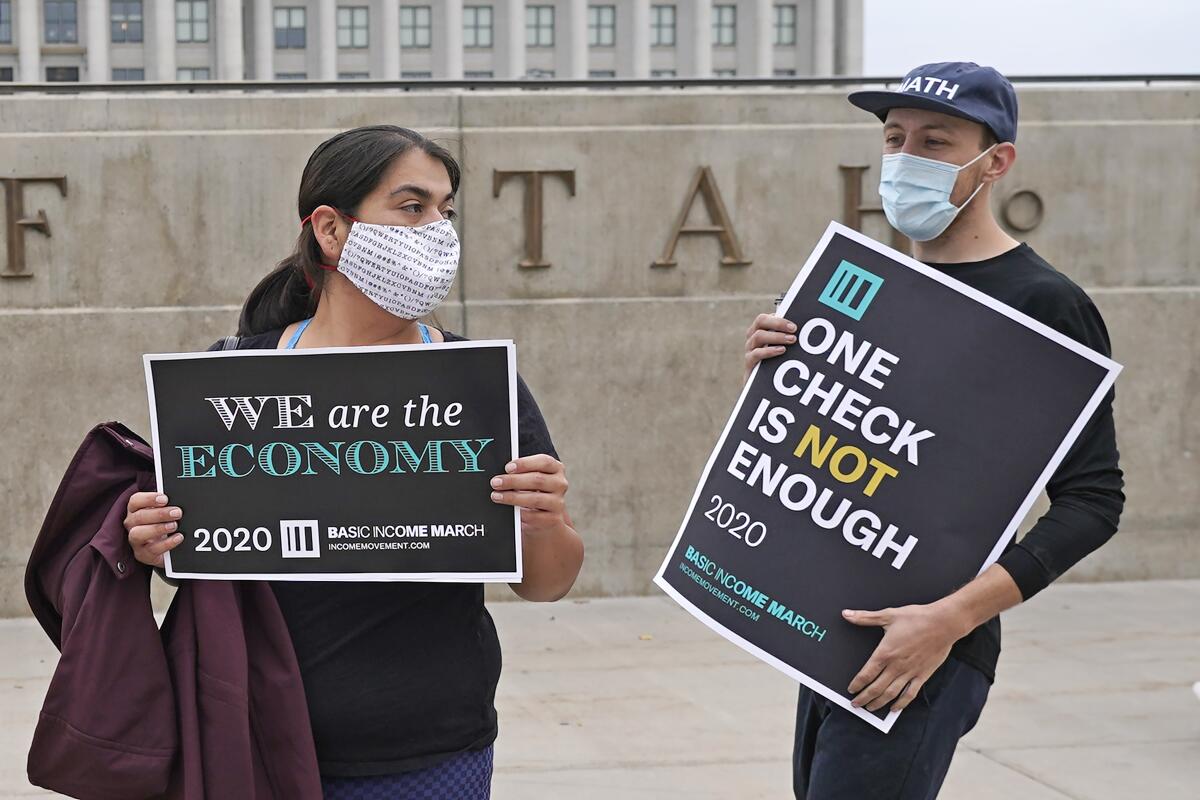Editorial: America is taking baby steps towards universal basic income

- Share via
The $1.9-trillion COVID-19 relief bill that President Biden signed into law Thursday includes an initiative that looks a lot like guaranteed income for families. Starting in July, parents of children ages 17 and younger will get monthly cash grants of up to $300 per child, to spend however they please.
Could this be the start of a broader effort to combat poverty with bigger monthly checks? Some signs point to yes. Although no Republicans voted for the COVID bill, there has been bipartisan support in Congress for increasing the child tax credit and for turning it into a monthly payment, rather than a once-a-year reduction in one’s income taxes.
But once the extreme circumstances of the pandemic are behind us, the high political hurdles to guaranteed-income programs will remain. More data from more trials would help overcome those hurdles and show that such programs are sustainable, scalable and more effective than other approaches.
Consider, for example, how Republican Sens. Marco Rubio of Florida and Mike Lee of Utah, two proponents of much larger child tax credits, blasted the increase in the COVID relief bill because it made the money available to the indigent as well as the comfortable. “That is not tax relief for working parents; it is welfare assistance,” they complained in a statement last month.
Herein lies the biggest challenge for anti-poverty programs in general, and guaranteed income programs (or “universal basic income”) in particular. Like Rubio and Lee, many Republicans — and many Americans — argue that government aid should flow only to people who have earned it somehow, and that it should be temporary. It’s the flip side to the myth that government handouts breed dependence and indolence, rather than lifting people up to the point where they can escape poverty’s gravitational force.
Proponents of guaranteed income argue that the aid enables people to surmount the many obstacles they face to earning a decent living — something that the existing collection of safety-net programs often fails to do. By providing cash with no restrictions on how it’s spent, the programs are not only far cheaper to administer, they allow recipients to use the dollars to meet their own unique needs, which may be child care for some, tuition for others.
That was the thinking behind the Stockton Economic Empowerment Demonstration, a two-year experiment with guaranteed income in that beleaguered Central Valley city. Using money raised from donors, Stockton gave 125 low-income households chosen at random $500 each month with no strings attached. The experiment — championed by former Mayor Michael D. Tubbs, who lost his bid for reelection in November — ended in February, and a team of analysts recently released a preliminary report on the first year’s results.
It’s a rave review, which has been echoed in the media coverage, with much of the focus on the quality-of-life improvements reported by people who received the monthly payments. Those improvements were hardly surprising; the two bigger revelations were that only a tiny percentage of the money was spent on nonessentials (which is consistent with other research) and that the grants did not appear to deter work.
Specifically, the people receiving grants were more likely to gain full-time jobs that year than the people in the control group, although most people in both groups were not employed full-time. That difference in employment rates pushes back against the notion that cash grants reduce the incentive to work. But the number of people involved in the experiment was so small, the results aren’t much of a counterweight to the far more extensive real-world trials in the 1970s that led some analysts to believe (and others to dispute) that such programs encourage people to work less.
Not that working less is necessarily a bad outcome, if the time is instead devoted to training, education or child development. These programs are designed to help people focus on larger goals than just paying this week’s bills, while also enabling them to be better parents and community members. That’s one of the findings from Stockton too. As the study’s authors put it, “The alleviation of constant financial strain also generated increased bandwidth for goal-setting and risk-taking, both of which were previously limited by scarcity.”
To surmount the political hurdles, guaranteed-income advocates need more ammunition than the tiny Stockton study to counter the work-disincentive argument — especially as they try to move from donor-funded programs to taxpayer funding. Also needed are more experiments testing other anti-poverty strategies — for example, creating living-wage jobs and career paths for people who need them, or simply giving much larger amounts through existing programs — against the cash grants to see which ones are most cost-effective. In addition, they’ll have to grapple with issues of sustainability, eligibility and privacy. There’s no shortage of questions the Stockton grants did nothing to answer.
More to Read
A cure for the common opinion
Get thought-provoking perspectives with our weekly newsletter.
You may occasionally receive promotional content from the Los Angeles Times.










